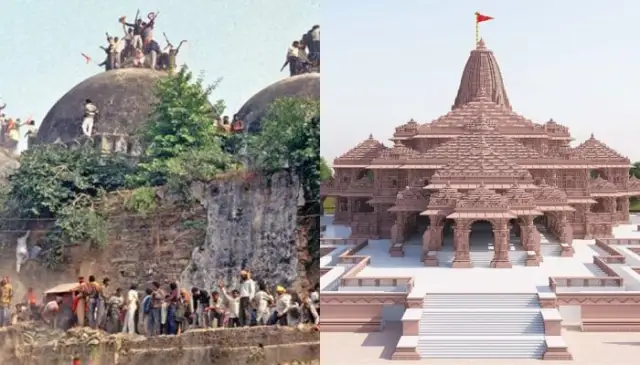Syed Zubair Ahmad
Satyameva Jayate- a mantra from the Hindu scripture Mundaka Upanishad became the national motto of India on 26 January 1950, following the country’s independence and its transition into a republic. Gone are the days when India and its people took pride in this motto as a representation of a universal truth.
However, the present scenario has seen a shift. Now everything has changed. An elected government is celebrating a shame, lies, cheat , deceit and falsehood for its petty political gain.
I didn’t intend to write this piece, but when I noticed the repeated lies of Rashtriya Swayamsevak Sangh chief Mohan Bhagwat about the demolition of Babri Masjid who claimed that ‘a long cherished dream is now being fulfilled with the construction of the Ram temple in Ayodhya while calling the demolished Babri mosque a ‘symbol of slavery’. I thought to put the facts on record before new generations so that they know how Muslims were cheated , their Mosque was invaded and snatched and hundreds of Muslims have been killed in this ‘process’.
In fact, entire Hindutva is based on the lies, bullies, cheat deceit and hatred against minorities specially against Muslims in India. The is the second time history that Hindutva forces are committing aggression in this peaceful city using all kinds tactics to grab the power in name of Rama.
What happened to Buddhists in Ayodhya
According to Encyclopaedia Britannica ‘In traditional history, Ayodhya was the early capital of the kingdom of Kosala, though in Buddhist times (6th–5th century BCE) Shravasti became the kingdom’s chief city. Scholars generally agree that Ayodhya is identical with the town of Saketa, where the Buddha is said to have resided for a time. Its later importance as a Buddhist center can be gauged from the statement of the Chinese Buddhist monk Faxian in the 5th century CE that there were 100 monasteries there (although he cited 100, Faxian probably did not mean that exact number, just that there were many monasteries). There were also a number of other monuments, including a stupa (shrine) reputed to have been founded by the Mauryan emperor Ashoka (3rd century BCE).
Throwing light on the history of Suryu River Dr Ambedkar wrote ‘the river flowing adjacent to present Ayodhya is known as Saryu but this river before reaching the city and after crossing it is called Gandak. He asks how this limited stretch of the river got a different name. He says “Sar” in Pali as well as in the local indigenous language means “head”. Using this clue he concludes that when Pushyamitra Shunga ordered his men to behead the Buddhist monks and masses, the river Gandak was filled with the heads of the Buddhists. This stretch of the river thus became known as Saryu (full of heads).
Interestingly, he said, the present Yogi government of Uttar Pradesh, in an attempt to erase the marks of this communal violence, has passed a resolution to rename Saryu river as Gandak. Not surprisingly, he is also following the age-old brahmanical tactics of renaming cities of historical importance.
In the words of Dr Ambedkar ‘the history of India is nothing but a mortal conflict between Buddhism and Brahmanism. He found that India has witnessed many violent communal onslaughts on the Buddhists.
1992- Second Hindutva attack on Ayaodhya
Unveiling the installation of Idol of Rama at Babri Masjid Krishna Jha and Dhirendra K. Jha’s book Ayodhya – The Dark Night , the story of how the mosque had turned into a temple overnight the authors wrote ‘on the morning of 23 December 1949, the First Information Report (FIR) registered by Ayodhya Police following the planting of the idol of Lord Rama in Babri Masjid on the night before had named Abhiram Das as the prime accused. He had also been tried for the crime he and his friends had committed that night, but the case had remained inconclusive. In course of time, many Hindus in Ayodhya had started calling him Ramajanmabhoomi Uddharak.
If there was a Ram Mandir in Ayodhya before Babur invaded, why did Tulsidas, who was a great disciple of Ram, never mention the temple in their historical accounts? Surprisingly the priest who had installed the idols of Rama in the Babri Masjid admitted his crime before camera.
Mohan Bhagwat must know that Supreme Court bench of Babri Masjid case has ruled that the Demolition of the Babri Masjid in 1992 and the 1949 desecration of the Babri Masjid was in violation of law. Both was criminal acts. That’s why to sooth Muslim sentiments the the court directed the government to provide an alternative 5 acres of land at a different location to the Uttar Pradesh Sunni Central Waqf Board for the construction of a mosque, serving as a replacement for the previously demolished Babri Masjid.
Mohan Bhagwat must know that the Ram Mandir is being built on lies and deceit. Kalyan Singh as UP’s chief minister, had filed an affidavit in the Supreme Court, assuring that the 16th century mosque will be protected. But he didnt keep his promise.
Singh also accepted that “Had there been no demolition, probably the courts too would have ordered status quo”.
Indeed, it is noteworthy and unsurprising that all five Supreme Court judges who pronounced the verdict in the Ram Janmabhoomi-Babri Masjid case in 2019 are currently benefiting from promotions or post-retirement benefits.
Justice Ranjan Gogoi, who was the then CJI is now a member of Rajya Sabha, Justices S A Bobde, is a Vice Chancellor , D Y Chandrachud is CJI, Justice Ashok Bhushan is NCLAT president and justice S Abdul Nazeer is enjoying as a governor.
The demolition of the Babri Masjid serves as an illustration of how Hindutva forces resort to falsehoods, deception, hatred to attain political power.










